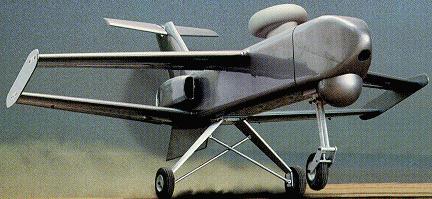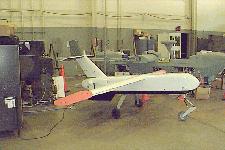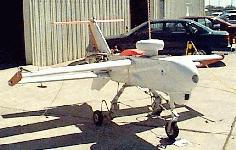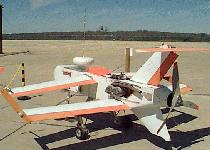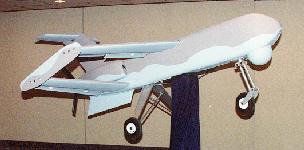




 The Outrider Tactical UAV [TUAV] program was an Advanced Concept Technology Demonstration
(ACTD) managed by the Program Executive Officer - Cruise
Missiles and Unmanned Aerial Vehicles (PEO(CU)), located in Crystal
City, VA. The Outrider TUAV program, formerly known as the Maneuver UAV, involved the development, production, and deployment of an unmanned aerial vehicle system that will provide near-real-time reconnaissance, surveillance, and target acquisition information to Marine air/ground task forces, Army brigades, and deployed Navy units. Requirements for the system were contained in Joint
Requirements Oversight Council Memorandum 150-95, while authority to
proceed with the ACTD was contained in the Acquisition Decision
Memorandum signed by the Under Secretary of Defense (Acquisition
and Technology) on 21 December 1995. Those mission
requirements included:
The Outrider Tactical UAV [TUAV] program was an Advanced Concept Technology Demonstration
(ACTD) managed by the Program Executive Officer - Cruise
Missiles and Unmanned Aerial Vehicles (PEO(CU)), located in Crystal
City, VA. The Outrider TUAV program, formerly known as the Maneuver UAV, involved the development, production, and deployment of an unmanned aerial vehicle system that will provide near-real-time reconnaissance, surveillance, and target acquisition information to Marine air/ground task forces, Army brigades, and deployed Navy units. Requirements for the system were contained in Joint
Requirements Oversight Council Memorandum 150-95, while authority to
proceed with the ACTD was contained in the Acquisition Decision
Memorandum signed by the Under Secretary of Defense (Acquisition
and Technology) on 21 December 1995. Those mission
requirements included:
The planned attrition rate for the Outrider UAV was 7% per year. The attrition rate for the Pioneer UAV was almost double the expected Outrider attrition rate, or almost 14%.
| Manufacturer: Alliant Techsystems |
Runway (ISA): unimproved surface: 100m |
RATO: no |
Dimensions: length-118.8 in. span-133.2 in. height- 61 in. |
| A/Vs in Baseline: 4 |
Data Link: Frequency: C-band Line of Sight: yes Satellite: no GPS: yes |
Range: up to 200km |
Power Plant: McCulloch 4318F 4 cyl./pusher |
| Fuel: type- heavy fuel capacity- 32 lts |
Endurance: 4.9 hours at 200km 7.2 hours at 50km |
Payloads: Color CCD FLIR Plug-in Optronic Payload(POP) |
Operational Altitudes (ISA): to 15,000ft. MSL |
| Speeds: stall- 34kts cruise-TBD kts dash-110 kts |
Max. Gross Take-off Weight: 385 lbs |
T/O cross winds- 20kts T/O head winds- 20kts rain- 1.2cm/hr visible moisture- limited icing- no turbulence- TBD |
Auto. Return Home on Data Link Loss: yes |
| Emergency Recovery: parachute |
Relay Flight Capability: no |
Multiple AV Control: yes, 2 |
Control Transfer to Another Shelter: yes |
The Department of Defense planned to acquire Tactical Unmanned Aerial Vehicle (TUAV) systems in a common configuration that meets the joint requirements of the Army, Navy, and Marine Corps. These systems comprise fully integrated components, including: air vehicle, sensor payloads, C4I interface systems, ground control elements, launch and recovery equipment, and may include automatic take-off and landing subsystems. The TUAV system were expected to successfully operate within the mobility and transportability constraints of the Army, Navy, and Marine Corps.
Evidence of the military utility of a land-based UAV was provided by the Outrider advanced concept technology demonstration (ACTD); nevertheless, a fully joint program could not be accomplished. Consequently, joint requirements were modified to permit use of more than one type of air vehicle. The Army and Navy initiated programs for land-based and sea-based UAV systems, respectively. The Navy seeks to develop a vertical takeoff and landing UAV for use on ships with small landing areas and in urban areas ashore. To ensure joint interoperability, both the Army and Navy UAVs will incorporate the Tactical Control System (TCS), which is designed to permit flexible control of all tactical unmanned air vehicles. TCS also will be used to control Predator endurance UAVs operated by the Air Force. The TCS program itself, originally scheduled to enter low-rate production in FY 1999, was restructured to accommodate changes in tactical UAV fielding schedules.
Since several companies were independently developing air vehicles for other purposes, the Department wished to remain fully informed of alternative systems and air vehicle capabilities. The Department continued to monitor alternatives that could meet the TUAV requirements and adjust any future development and acquisition programs to take full advantage of commercial progress and to maintain competition. This may occur at either the system level or at the air vehicle level.
With this in mind, NAVAIR conducted a market survey for the Department to obtain industry input relative to its current capabilities to satisfy the fully documented Joint Tactical UAV requirements. This Request for Information is soliciting any information on current, demonstrated performance and capabilities of the respondent�s system/air vehicle as it relates to the joint performance parameters, as well as information on existing systems/air vehicles that meet or exceed either of two component requirements: 50 km land or 200 km maritime. System maturity, as evidenced by demonstrated performance and flight data from off-the-shelf systems/air vehicles was highly preferable; lengthy development alternatives were not desired.
|
Parameter |
Joint |
50 km Land |
200 km Maritime |
|
Range |
200 km |
50 km (100 km) |
200 km |
|
Endurance @ Range |
3 hrs @ 200 km |
3 hrs On Station |
3 hrs @ 200 km |
|
Payload |
EO/IR |
EO/IR |
EO/IR |
|
TLE |
<100 m |
<100 m (<80 m) |
< 100 m (<80 m) |
|
Data Link |
Analog (Digital) |
Analog (Digital) |
Analog (Digital) |
|
IFF Tansponder |
Mode IIIC (Mode IV) |
Mode IIIC (Mode IV) |
|
|
Propulsion * |
As Provided (HFE*) |
(HFE*) |
HFE* |
|
TCS Compatible |
Yes |
Yes |
Yes |
|
Launch & Recovery |
Unprepared Surface / Large Amphib Ship |
Unprepared Surface |
Shipboard - |
|
Autonomous Landing |
Yes - UCARS Option |
Yes - UCARS Option |
|
|
Deployability |
1 C-130 |
1 C-130 for 72 hr Continuous Ops; NTE 2 C-130s for System |
All Air Capable Ships |
|
Mobility / footprint |
2 HMMWVs w/1 Trailer |
2 HMMWVs w/2 Trailers |
Shipboard Compatible |
|
Remote Video Terminal |
50 km w/ metadata |
200 km w/ metadata |
|
|
Air Vehicle Cost |
$350/33rd Unit $300/100th Unit |
$350/33rd Unit $300/100th Unit |
|
|
|||
